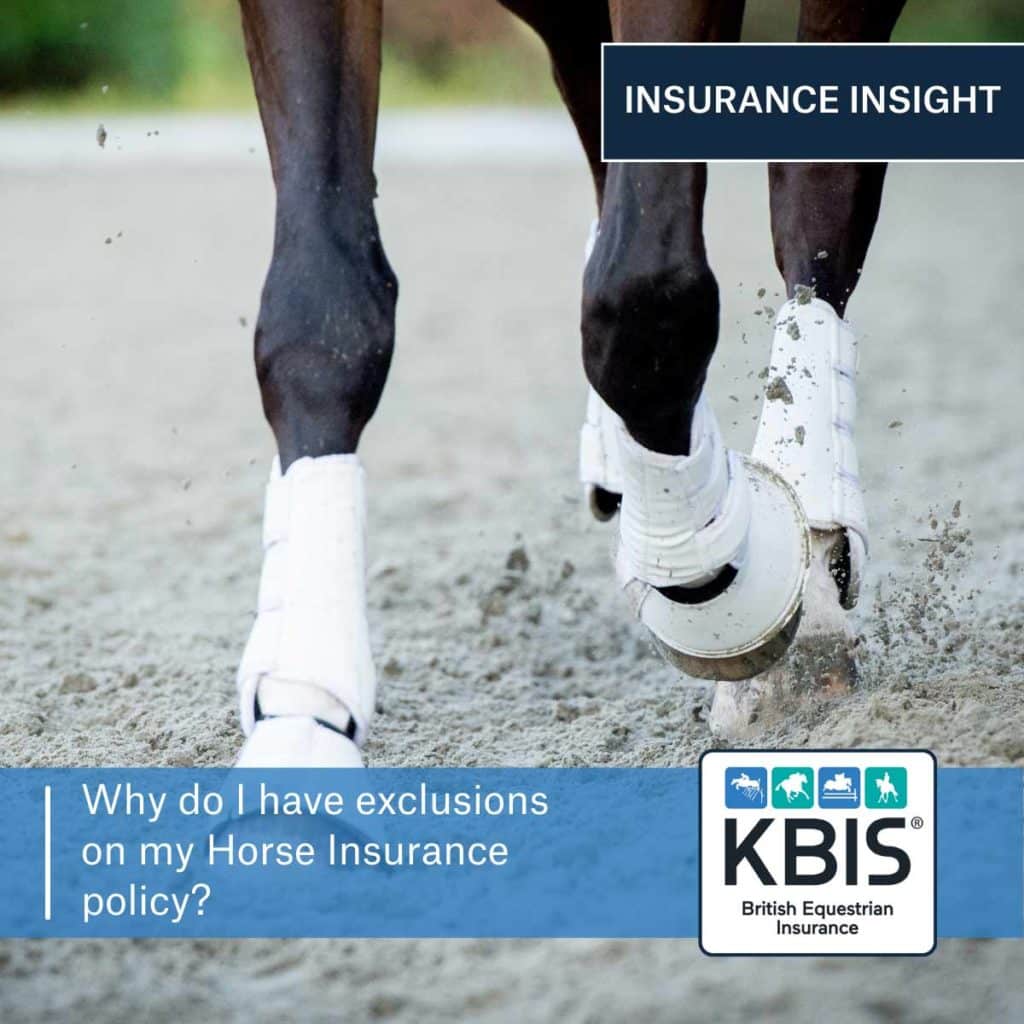Exclusions are a hot topic when it comes to horse insurance policies. They are often a deciding factor on whether you choose to insure, the level and type of insurance you opt for, and perhaps most importantly, they have a strong bearing on the actual cover you have in place. At KBIS, we pride ourselves on being transparent when it comes to exclusions, that’s why we put together this guide on why exclusions are placed, how you can request that they are lifted and what options you have following an exclusion review.
Why are exclusions placed?
Exclusions are placed on horse insurance policies for any conditions that pre-exist the start date of cover. Why? Because insurance is designed to protect you against unforeseen or unexpected risks. Previous problems that are known about remove the unexpected element and it is much more likely that further issues in the same area or those that relate to the previous condition may happen again and therefore an exclusion is placed.
Exclusions are vital in ensuring only legitimate claims are paid out by Underwriters. By making sure claims are not paid for issues that occurred before the start of the policy or relate to conditions that did, exclusions serve to keep premiums as low as possible.
How are exclusions decided?
When taking out a horse insurance policy, there are certain documents you will need to supply such as a vetting (see our article on Do I need a vetting to insure my horse?) and veterinary history, which you can request from your vet if required. Exactly what is needed will be confirmed by the insurance company when you get a quote as it depends on certain details such as the value of the horse, how long you have owned him/her etc.
Based on these documents, at KBIS, a full list of exclusions are then noted on your policy to ensure it is clear what your horse is not covered for and what limitations there are on the policy as a result. This means there are no nasty surprises when it comes to submitting a claim, as the conditions/areas not covered by the policy are listed on each copy of your documents.
Why do routine joint injections result in an exclusion?
There is sometimes confusion around why having your horse maintained by routine joint injections means an exclusion is placed on the policy for that joint. Once an inter-articular injection is administered into a joint, that joint is then excluded going forwards other than for any accidental external injuries. This is because regardless of whether they are given as routine maintenance; joint injections are medication.
By consistently medicating a joint, you are technically already giving your horse a treatment, whether that is to improve existing symptoms or to prevent them from coming to light, it is still medication. Routine injections must be disclosed to your insurer in order to allow them to underwrite your policy correctly and again so that you know exactly what exclusions apply to the policy to know where you stand in the event of a claim.
How can I get exclusions reviewed?
KBIS understands that you may not agree with the exclusions applied to your policy. Unfortunately, it is not feasible to automatically review exclusions as we do not always have all of the relevant facts to be able to do so. We do, however, have a simple exclusion review process that, if followed, allows our exclusions team to come back to you directly on whether an exclusion is able to be lifted or made more specific in any way after discussing your specific case with Underwriters. The process is to email exclusions@kbis.co.uk with the following information:
- The onset date of the condition the exclusion relates to
- The nature of the problem at the time i.e. poor performance, lameness
- Any treatment your horse received
- Confirmation that your horse has fully recovered and returned to the same level of work they undertook before the problem and is currently fit and well with no other ongoing issues.
- A copy of the horse’s full medical history (you can obtain this from your veterinary surgeon who can often send this directly to us)
What are my options following an exclusion review?
There are some exclusions which an Underwriter will not remove, this is because the problem could be ongoing, present a higher risk of reoccurrence or predispose the horse to further problems. If the outcome of the exclusion review is not what you had hoped for, you may want to consider a more limited policy where the premium is cheaper as a result. One option for this would be Catastrophe Cover. This may be more cost-effective as you are not paying for cover you cannot access but have security knowing that the cost of any treatment for open wounds plus 3 major and expensive surgeries would be covered (providing your horse has not had colic surgery before).
If you have found this article helpful and are after more insurance insights, check out our 5 ways to make your horse insurance claim as smooth as possible.

